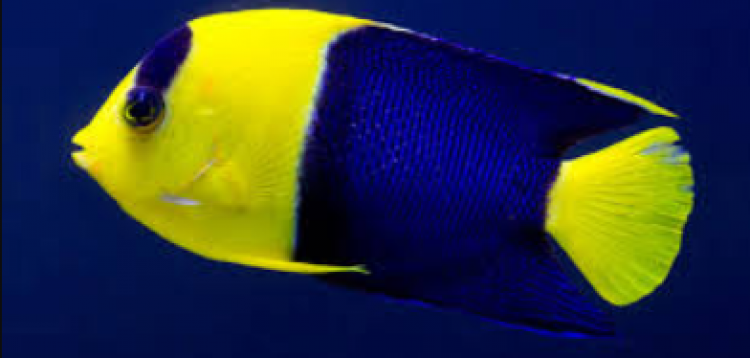- Name:
Golden Angelfish
(View AKA's) - Family: Pomacanthidae
- Species: Angel Dwarf
- Scientific Name: Centropyge aurantia


General info about Golden Angelfish
The Golden Angel is a hard to find species is cryptic in nature, making them both difficult to acquire and a prized fish in the hobby. This species is identified by its velvet looking burnt orange/red coloration with thin, broken yellow vertical bars running along each side of the body. This angelfish is best kept as the only dwarf angel in a tank. It will adjust rapidly if it is introduced as one of the first fish in a well-established aquarium, or if it is introduced and maintained with very peaceful tankmates. Caution should be used if there is an abundance of LPS and SPS coral in the tank. This species has been known to nip at these corals as well as Xenia corals. In most cases, the fish will not damage these corals, but rather just irritate them.
Golden Angelfish Diet & Nutrition
The Golden Angel is an omnivore feeding on a mixture of algae, coral polyps, sponges and diatoms in the wild. In tank conditions, these angelfishes may be fed with a variety of food source such as dried flakes, food products with sponge and spirulina material, and meaty foods like shrimp and crustaceans. To encourage feeding, opening a clam or other marine flesh may entice the Golden Angelfish to feed in aquarium conditions.
Determining Sex of Golden Angelfish
Male Golden angelfishes are larger than female angelfishes, just like other Centropyge species due to their protogynous hermaphroditism. Its color does not indicate sexual dimorphism. Golden angelfishes aggregate together in harems, when the male dies, the next dominant female will change in sex to assume the role of the male in the group.
Breeding & Spawning Golden Angelfish
Golden Angels are difficult to breed in captivity. In the wild, Golden Angels form pairs or harems with 1 male and many female individual. Courtship occurs at dusk when the male soars above the female, hovers with his fins extended, and tilts at a 45-90 degree angle from the bottom. When the female is ready to spawn, it follows the male and initiates spawning with a mutual soaring display. Gametes will then be broadcast into the water column for external fertilization to occur. After a day, eggs are ready to hatch and after 2-3 days these larvae should be fed with microscopic algae.
Common Diseases with Golden Angelfish
Dwarf angelfishes like Golden Angelfish are vulnerable to bacterial diseases, parasitic and protozoan diseases, and physical ailment due to mishandling. It might be able to contract common bacterial diseases such as Cotton wool disease, Vibrio bacterial disease, and Fish tubercolosis. Cotton wool disease is exhibited as an expanding translucent layer that eats away on the skin. Vibrio Bacterial disease on the other hand are exhibited by Dropsy, Popeye, Bleeding or Red Streaks on the skin. Lastly, Fish T.B. usually shows up as a loss of color and swelling of the body. It can also display blood streaks and blood spots anywhere in the body.
Common reef scourges such as the Crypt or White Spot Diseases and Velvet Disease may infect Angel Goldenfishes if not well cared for. Tiny white spots on the skin of the fish is one of the tell-tale sign of infection of the Crypt while dusty golden film on the skin or the eyes of the angelfish will detect the presence of Velvet Disease.
Golden Angelfish Origin
Centropyge aurantia are widely distributed in the western Pacific, from the northern Great Barrier Reef to Samoa, including Indonesia. Other parts include Papua New Guinea, the Solomon Islands, Pohnpei, Palau, Vanuatu, Tonga, American Samoa, and in Fiji.
Caution with Golden Angelfish
Golden Angelfish is a very sought after and moderately difficult to keep in an aquaria due to its cryptic and shy nature. They tend to hide out instead of venturing out for food.
It is recommended to be kept in fish only aquariums with peaceful tankmates, and is not suggested to be kept with other dwarf angelfish unless as a pair in a large tank. Suggested tankmates includes smaller and 'weaker' cardinalfish, gobies, tilefish, non-aggressive butterflyfish, fairy basslets, fairy and flasher wrasses. Larger wrasses and fast swimming fish can intimidate this dwarf angel.
Golden angelfishes are also known to nip some species of hard and soft corals, hence it is good to keep a close eye on these dwarf angels.
Acclimating Golden Angelfish
It is best to keep Golden Angelfishes alone in the tanks in the beginning to help them acclimate before adding the other suitable tankmates. Pristine and highly oxygenated water is very important for success in acclimation in tank conditions.
Original Detail
| Name | Species | Family | Scientific Name | More Detail | Added by |
|---|---|---|---|---|---|
| Golden Angelfish | Angel Dwarf | Pomacanthidae | Centropyge aurantia | The Golden Angel is a hard to find species is cryptic in nature, making them both difficult to acquire and a prized fish in the hobby. This species is identified by its velvet looking burnt orange/red coloration with thin, broken yellow vertical bars running along each side of the body. This angelfish is best kept as the only dwarf angel in a tank. It will adjust rapidly if it is introduced as one of the first fish in a well-established aquarium, or if it is introduced and maintained with very peaceful tankmates. Caution should be used if there is an abundance of LPS and SPS coral in the tank. This species has been known to nip at these corals as well as Xenia corals. In most cases, the fish will not damage these corals, but rather just irritate them. |
PalaciosAn |
Changed by users
| Submitted Date | Submitted By | Status | Action |
|---|




